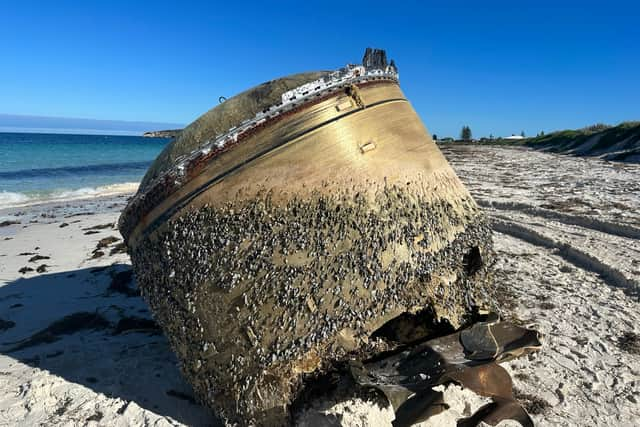Unidentified 'giant' object in Australia confirmed to be from an Indian rocket
and live on Freeview channel 276
India has confirmed that a giant "unidentified" dome that washed up on a West Australian beach was from one of its rockets.
The canister washed up on a beach at Green Head, located around 250 kilometres north of Perth, on Sunday 16 July.
Advertisement
Hide AdAdvertisement
Hide AdIndia's space agency spokesman told the BBC on Monday (31 July) it was from one of its Polar Satellite Launch Vehicles (PSLV).
The Australian Space Agency (ASA) said it was working with India's space agency to "determine next steps, including considering obligations under the United Nations space treaties".
State and federal authorities investigated the item when it was first found and treated it as hazardous, with people being asked to keep a safe distance. However, now they advise it poses no risk to the public.


According to ABC News, European Space Agency engineer Andrea Boyd said experts believed the item fell from an Indian rocket launching a satellite when it was first discovered.
Advertisement
Hide AdAdvertisement
Hide AdShe said: "We're pretty sure based on the shape and the size, it is an upper-stage engine from an Indian rocket that's used for a lot of different missions. India has been using them since the 90s and they've launched more than 50 missions.
"Based on the amount of barnacles, it's probably not the one from this year."
She said it could be around 20 years old, but also as things get thrown in the ocean, they tend to look older.
Ms Boyd said the engine was designed to fall off after launch.
Advertisement
Hide AdAdvertisement
Hide Ad"It takes a lot of effort to get up to orbit, so the first and second and third stage engines usually fall off and end up in the Indian Ocean, so it's probably come from that with the currents and washed up on the beach," she said.
WA Police has released a statement saying it is liaising with national agencies, including the Australian Space Agency, to identify the object and its origin.
It said: "WA Police Force has commenced discussions with several state agencies and the Shire of Coorow in relation to the planned safe movement and storage of the object, which will factor in additional precautions given the unknown origin of the object".
WA Premier Roger Cook on Tuesday suggested the debris could become part of a local display.
Advertisement
Hide AdAdvertisement
Hide AdHe said: “The consensus seems to be growing that it’s probably some returning space debris. Perhaps this would be an addition to the Skylab pieces that we have in the museum and might add to our growing collection of space debris which seems to be collecting in WA.”
The Skylab space station came crashing back to Earth in 1979, with pieces of the station fund in the most remote outback locations of Balladonia, north-east of Esperance in WA’s south.
Comment Guidelines
National World encourages reader discussion on our stories. User feedback, insights and back-and-forth exchanges add a rich layer of context to reporting. Please review our Community Guidelines before commenting.
